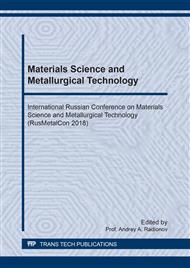[1]
L. Z. Bykhovskiy, N. A. Arkhipova, Strategic rare metal supply in Russia: Current state and future prospects, Gornyi Zhurnal, 7 (2017) 4-10.
DOI: 10.17580/gzh.2017.07.01
Google Scholar
[2]
A. V. Lapin, A. V. Tolstov, I. M. Kulikova, Distribution of REE, Y, Sc, and Th in the unique complex rare-metal ores of the Tomtor deposit. Geochemistry International, 54 (2016) 1061-1078.
DOI: 10.1134/s0016702916120065
Google Scholar
[3]
N. Yu. Samsonov, A. V. Tolstov, N. P. Pokhilenko, V. A. Kryukov, S Khalimova, Possibilities of Russian hi-tech rare earth products to meet industrial needs of BRICS countries. African Journal of Science, Technology, Innovation and Development, 6 (2017) 1-8.
DOI: 10.1201/9781003008774-11
Google Scholar
[4]
A.A. Pakhomov, Yu.G. Danilov, Prospects for development in the mining industry in the Western Yakutia. Gornyi Zhurnal, 9 (2016) 27-32.
DOI: 10.17580/gzh.2016.09.05
Google Scholar
[5]
Biao Wu, He Shang, Jian-Kang Wen, Sulfuric acid leaching of low-grade refractory tantalum-niobium and associated rare earths minerals in Panxi area of China, Rare Metals, 34 (2015) 202-206.
DOI: 10.1007/s12598-014-0436-7
Google Scholar
[6]
A. V. Tolstov, A. D. Konoplev, V. I. Kuz'min, Osobennosti formirovaniya unikal'nogo redkometall'nogo mestorozhdeniya Tomtor i otsenka perspektiv yego osvoyeniya, Razvedka i okhrana nedr, 6 (2011) 20-25.
Google Scholar
[7]
P. S. Kindyakov, B. G. Korshunov, P. I. Fedorov, I. P. Kislyakov, Khimiya i tekhnologiya redkikh i rasseyannykh elementov, Moskva (1976).
Google Scholar
[8]
Aly M Abdel-Rehim, An innovative method for processing Egyptian monazite, Hydrometallurgy, 67 (2002) 9-17.
DOI: 10.1016/s0304-386x(02)00134-2
Google Scholar
[9]
J. Zhang, C. Edwards, Mineral decomposition and leaching processes for treating rare earth ore concentrates. Canadian Metallurgical Quarterly, 52 (2013) 243-248.
DOI: 10.1179/1879139513y.0000000084
Google Scholar
[10]
Wang Weiwei, Yoko Pranolo, C. Y. Cheng, Metallurgical processes for scandium recovery from various resources: A review. Hydrometallurgy, 108 (2011) 100-108.
DOI: 10.1016/j.hydromet.2011.03.001
Google Scholar
[11]
M. Y. Malkova, A. N. Zadiranov, A study on kinetics of roasting of ore from tomtor field. RUDN Journal of Engineering Researches, 19 (2018) 92-101.
DOI: 10.22363/2312-8143-2018-19-1-92-101
Google Scholar
[12]
Archana Kumari, Rekha Panda, Manis Kumar Jha, Jin Young Lee, J. Rajesh Kumar, Vinay Kumar, Thermal treatment for the separation of phosphate and recovery of rare earth metals (REMs) from Korean monazite, Journal of Industrial and Engineering Chemistry, 21 (2015) 696-703.
DOI: 10.1016/j.jiec.2014.03.039
Google Scholar
[13]
Wen-yuan WU, Xue BIAN, Zhi-ying WU, Shu-chen SUN, Gan-feng TU, Reaction process of monazite and bastnaesite mixed rare earth minerals calcined by CaO-NaCl-CaCl2, Transactions of Nonferrous Metals Society of China, 17 (2007) 864-868.
DOI: 10.1016/s1003-6326(07)60189-7
Google Scholar
[14]
Yanhui XU, Haijiao LIU, Zhijun MENG, Jianguo CUI, Wenyi ZHAO, Liangcai LI, Decomposition of bastnasite and monazite mixed rare earth minerals calcined by alkali liquid, Journal of Rare Earths, 30 (2012) 155-158.
DOI: 10.1016/s1002-0721(12)60014-3
Google Scholar
[15]
Chen B, Wu F, Liu F, Experimental study on the effects of organic acids on the dissolution of REE in the weathering crust of granite, Chinese Journal of Geochemistry, 20 (2001) 144-151.
DOI: 10.1007/bf03165996
Google Scholar
[16]
Archana Kumari, Rekha Panda, Manis Kumar Jha, J. Rajesh Kumar, Jin Young Lee, Process development to recover rare earth metals from monazite mineral: A review, Minerals Engineering, 79 (2015) 102-115.
DOI: 10.1016/j.mineng.2015.05.003
Google Scholar
[17]
Wantae Kim, Inkook Bae, Soochun Chae, Heeyoung Shin, Mechanochemical decomposition of monazite to assist the extraction of rare earth elements, Journal of Alloys and Compounds, 486 (2009) 610-614.
DOI: 10.1016/j.jallcom.2009.07.015
Google Scholar
[18]
S. S. Naboychenko, Avtoklavnaya gidrometallurgiya tsvetnykh metallov, Yekaterinburg, UGTU-UPI (2009).
Google Scholar
[19]
Eunyoung Kim, K. Osseo-Asare, Aqueous stability of thorium and rare earth metals in monazite hydrometallurgy: Eh–pH diagrams for the systems Th–, Ce–, La–, Nd– (PO4)–(SO4)–H2O at 25 °C, Hydrometallurgy, 113–114 (2012) 67-78.
DOI: 10.1016/j.hydromet.2011.12.007
Google Scholar
[20]
B. M. Ravich, Kompleksnoye ispol'zovaniye syr'ya i otkhodov, Moskva (1988).
Google Scholar


